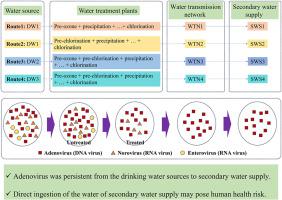Virus contamination, removal characteristics and quantitative risk assessment from drinking water source to secondary water supply system
IF 8.7
Q1 Environmental Science
引用次数: 0
Abstract
The drinking water (DW) supply system is the last line of defense against virus infections for people's DW health. This study systematically evaluated the virus pollution characteristics and human health risks in the entire DW supply systems. The detection frequency range of the virus in DW was 5.30 %–71.21 %, and the concentration range at not detected (n.d.) - 1.45 × 105 copies/L. DNA virus like adenovirus was more persistent than RNA viruses like norovirus and enterovirus in the DW system. Drinking water treatment plants (DWTPs) play a crucial role in reducing the target virus with degradation rates ranging from 47.09 % to 100 % when compared with the removal rates in DW source and secondary water supply (SWS). It was found the persistence and accumulation of the virus in the treated water from DWTPs to the downstream water transmission network. Principal component analysis showed that the virus contamination was positive correlation with water quality indexes like total phosphorus, total nitrogen, dissolved oxygen but negative correlation with temperature and the dose of free chlorine. Quantitative microbial risk assessment of adenovirus in the SWS showed that the DALYs/person/year of gastroenteritis ranged from 8.11 × 10−6 to 2.68 × 10−4 DALYs/person/year. Uncertainty analysis of different distributions of model inputs like virus concentrations showed the risk caused by adenovirus was changed appreciably for different person by using 100,000 Monte Carlo simulations. It is necessary to efficiently remove the virus in the DW systems to ensure human health for the direct ingestion of secondary water supply water.

饮用水水源至二次供水系统的病毒污染、去除特征及定量风险评估
饮用水供应系统是保障人体健康、抵御病毒感染的最后一道防线。本研究系统评价了整个污水供应系统的病毒污染特征和人体健康风险。病毒在DW中的检测频率范围为5.30% ~ 71.21%,未检出浓度范围为1.45 × 105拷贝/L。DNA病毒类腺病毒比RNA病毒类诺如病毒和肠病毒在DW系统中的持久性更强。饮用水处理厂(DWTPs)在减少目标病毒方面发挥了至关重要的作用,与DW源和二次供水(SWS)相比,其降解率在47.09%至100%之间。发现该病毒在污水处理厂处理后的水中持续存在并积累到下游的水传输网络。主成分分析表明,病毒污染与总磷、总氮、溶解氧等水质指标呈正相关,与温度、游离氯剂量呈负相关。SWS腺病毒定量微生物风险评估结果显示,胃肠炎DALYs/人/年为8.11 × 10−6 ~ 2.68 × 10−4 DALYs/人/年。对病毒浓度等不同模型输入分布的不确定性分析表明,通过10万次蒙特卡罗模拟,腺病毒引起的风险在不同的人身上有明显的变化。有必要有效地清除污水系统中的病毒,以确保人类健康直接摄入二次供水水。
本文章由计算机程序翻译,如有差异,请以英文原文为准。
求助全文
约1分钟内获得全文
求助全文
来源期刊

Water Cycle
Engineering-Engineering (miscellaneous)
CiteScore
9.20
自引率
0.00%
发文量
20
审稿时长
45 days
 求助内容:
求助内容: 应助结果提醒方式:
应助结果提醒方式:


